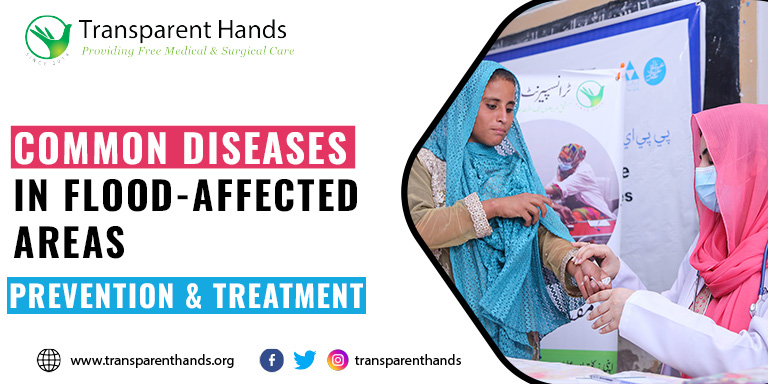Common Diseases in Flood-affected Areas: Prevention & Treatment

Floods are natural disasters that can cause severe damage to both people and the environment. In Pakistan, floods are a common occurrence during the monsoon season, affecting millions of people and causing extensive damage to infrastructure, crops, and livestock. They also pose a significant health risk to the affected population, with common diseases in flood-affected areas being a major concern. In this article, we will discuss the common diseases that affect flood-hit areas and how to prevent and treat them.
Common Diseases in Flood-affected Areas:
1. Water-borne Diseases
Water-borne diseases are the most common ones that occur in flood-affected areas. These diseases are caused by microorganisms that contaminate water sources, including rivers, streams, and wells. Common water-borne diseases include cholera, typhoid fever, dysentery, and hepatitis A.
Prevention:
The best way to prevent water-borne diseases is to avoid drinking contaminated water. Boiling water before drinking or using water purification tablets can also help in preventing water-borne diseases.
Treatment:
Treatment for water-borne diseases involves rehydration therapy and antibiotics in some cases. If you experience symptoms such as diarrhea or vomiting, seek medical attention immediately.
2. Vector-borne Diseases
Vector-borne diseases are those that are transmitted by insects such as mosquitoes, ticks, and flies. These diseases are prevalent in flood-affected areas as stagnant water serves as a breeding ground for insects. Common vector-borne diseases include malaria, dengue fever, and West Nile virus.
Prevention:
To prevent vector-borne diseases, it is essential to use mosquito nets, wear protective clothing, and use insect repellent. Eliminating stagnant water sources can also help in reducing the number of insects in the area.
Treatment:
Treatment for vector-borne diseases involves medications to manage symptoms and prevent complications. Seek medical attention immediately if you experience fever, headaches, or body aches.
3. Respiratory Infections
Respiratory infections such as pneumonia and bronchitis are also common in flood-affected areas. These infections are caused by bacteria or viruses that can spread through the air or by direct contact with contaminated surfaces.
Prevention:
To prevent respiratory infections, it is essential to maintain good hygiene practices, such as washing your hands regularly and covering your mouth and nose when coughing or sneezing. Avoid crowded areas if possible and wear a mask if you are in a crowded area.
Treatment:
Treatment for respiratory infections involves antibiotics, antiviral medication, or supportive care such as oxygen therapy. Seek medical attention if you experience difficulty breathing, chest pain, or persistent coughing.
Conclusion
In conclusion, floods can have severe health consequences, with common diseases in flood-affected areas being a significant concern. Water-borne diseases, vector-borne diseases, and respiratory infections are the most prevalent diseases in flood-affected areas. Prevention measures such as maintaining good hygiene practices, using mosquito nets, and avoiding contaminated water sources can help in reducing the incidence of these diseases. If you experience symptoms of any of these diseases, seek medical attention immediately.










Leave Your Comments